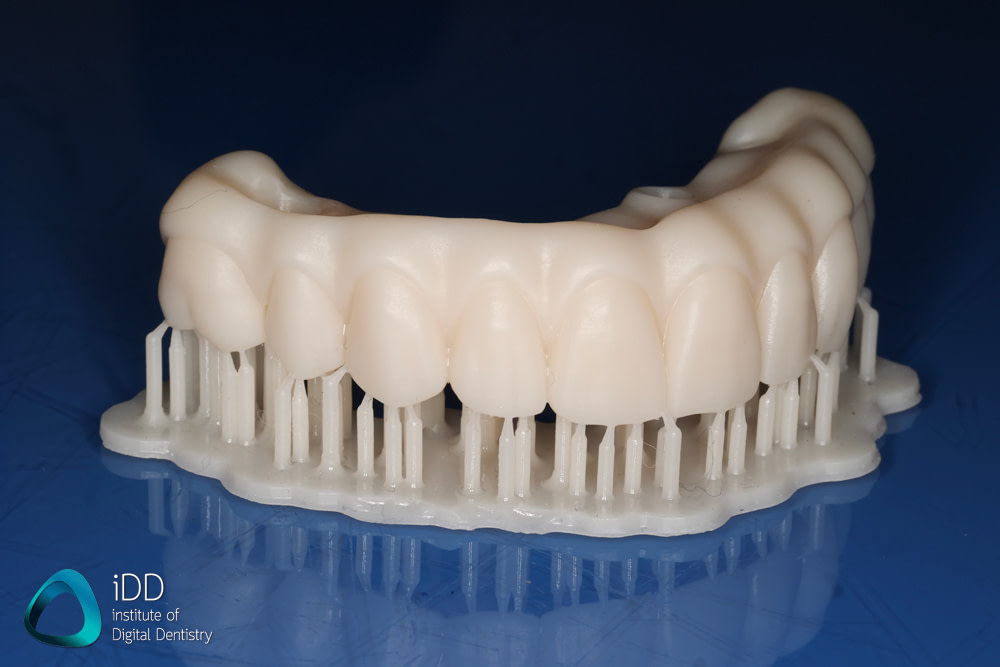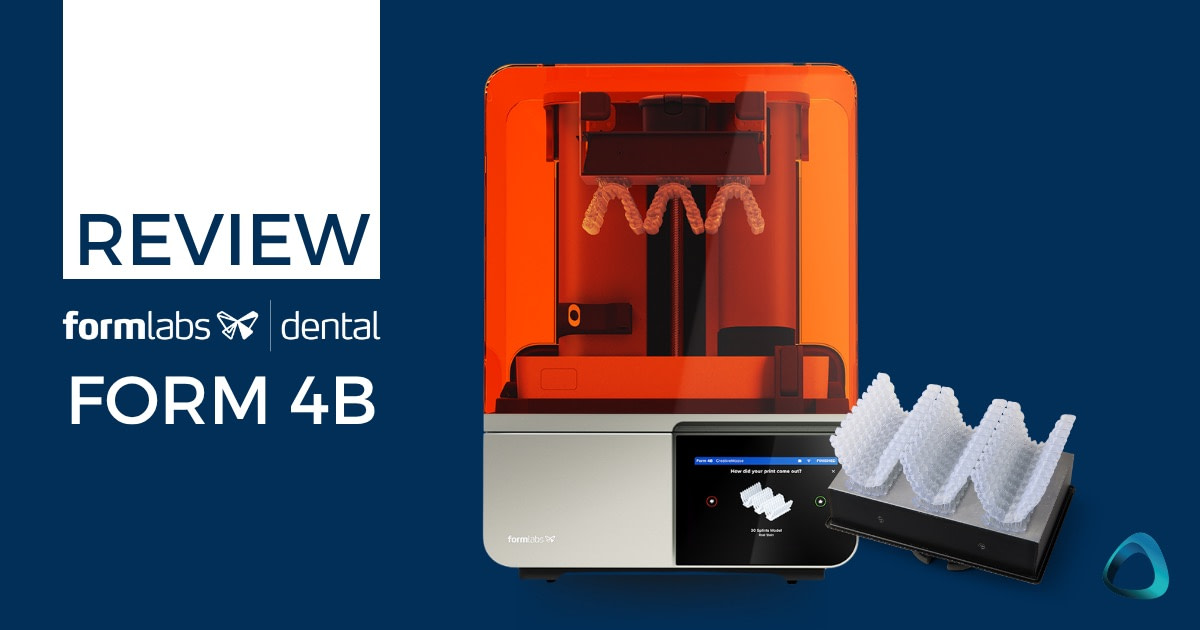After testing the Formlabs Form 4B printer extensively in our clinic and lab for close to a year, I'm ready to share my in-depth thoughts on this latest dental 3D printer from Formlabs.
Having put it through its paces with numerous applications, I can tell you upfront – I actually really like this printer. It does a lot of things right, but like any product, it comes with both strengths and limitations.
Continue reading below the full review or watch the video!
What is Form 4B?
The Form 4B is Formlabs' newest dental 3D printer, building on their Form 2 and Form 3B technology but with significant improvements. This printer is much faster, features a better looking design, and offers several quality-of-life enhancements over previous Formlabs models. This includes better cartridges and improved print technology, it stands as the only Formlabs dental printer I would seriously consider purchasing in today's market.

Form 4B 3D printer by Formlabs
The Technology: MSLA with Low Force Display
Let's dive into the technology, which is interesting and indicates a general shift in dental 3D Printing from SLA to DLP to LCD technology.
The Form 4B uses what Formlabs calls MSLA (Masked Stereolithography) printing technology, powered by their Low Force Display system. This represents a complete departure from previous generation printers with entirely new hardware.
Essentially it is a LCD printer but with some interesting features.
The print engine includes the following components:
- A backlight unit featuring 60 LED lights
- A baffle and lens array that creates collimated (parallel) and uniform light
- An integrated cooling system
- The Light Processing Unit 4 with a metallic frame, LCD screen, and release texture


The proprietary "Release Texture" is particularly notable – a microtextured optical film that provides airflow and reduces forces exerted on parts during printing. This film sits between the flexible film in the resin tank and the light processing unit, preventing suction and allowing for faster and more reliable prints.
The printer also incorporates intelligent control systems that monitor temperature, resin level, and print forces, along with cameras for remote monitoring and various sensors to ensure optimal printing conditions.
What this all means and something I really like about the Formlabs printers is how reliable they are. I seriously cannot remember the last time I had a failed print. Easy to use and it just works.
Open Material Mode: A Significant Advancement
Perhaps the most exciting development for the Form 4B is the recently launched open material mode.
This feature allows you to unlock your printer to work with third-party resins beyond Formlabs' proprietary materials - a significant departure from their previously closed ecosystem. One of the best releases for Formlabs Dental for sure.
This addresses one of the main historical downsides of Formlabs printers. With open material mode, you're no longer restricted to Formlabs resins, opening up competitive options from other manufacturers. You can select materials based on specific case requirements, cost considerations, or personal preferences.
Formlabs is also validating more third-party resins including 2 hard hitters - Pac-Dent resins for full arch and restorative indications and Lucitone for denture indications.
I've tested Pac-Dent Titan extensively for full arch restorations, and it is one of the best full arch resins on the market. So it is nice to see it finally come to Formlabs.
Formlabs Dental also recently announced validation for Lucitone, making it one of only a few printers (alongside Carbon, Asiga, and PrimePrint) to have this validation.

Setup, Software, and Usability
Getting started with the Form 4B is very straightforward. These printers are user-friendly.
The unboxing and setup process is plug-and-play with helpful on-screen prompts. No technician is needed, which highlights one of Formlabs Dental's greatest strengths – ease of use.
Their software, PreForm (now with a specific dental version called PreForm Dental), makes it easy to nest, add supports, add text, create honeycomb models, and print all dental indications. Whether you need models, surgical guides, or restorations, the software handles it efficiently. This is now expected in the dental printing market in 2025 - but not always achieved by all companies.
As mentioned prior - what's particularly impressive is the reliability. Misprints are rare, almost non-existent, right out of the box. According to independent third-party testing, the printer achieves a 99% success rate on prints, which is exceptional. The printer simply works, with the software effectively handling nesting and support creation regardless of print geometry.

Print Quality and Speed
The Form 4B delivers great print quality with smooth surfaces and precise geometries.
I recently printed a Bego VarseoSmile Triniq resin restoration for a full arch that looked great straight out of the printer, even before curing. See below.

Compared to previous generations, print speeds have improved dramatically. This addresses one of the other biggest criticisms of earlier Formlabs printers. Basically everything can be printed within 45-60 minutes now. This is thanks to LCD technology which is far superior to SLA when regarding print speeds.
Some modes are even faster like when printing using their draft resin (e.g for ortho models) and a larger layer thickness, you can print 11 aligner models sitting flat on one build platform in around 9 minutes.
The Form 4B handles everything from models and surgical guides to crowns and denture bases with consistent quality and accuracy, even after a years of regular use. It is actually a great printer for the cost.
Complete Ecosystem
One of the biggest strengths of Formlabs is the compete ecosystem:
- Printer
- Wash + Cure
- A great software
The Form 4B integrates seamlessly into this digital workflow. The PreForm Software is intuitive with dental-specific features that optimize prints for different applications.
The ecosystem also is complimented by a few cool features like the the Build Platform Flex, which makes part removal easy without hammers, scraping, or broken models.


The next big improvement to Formlabs Dental is the new Form Cure units. This deserves special mention, as it's been redesigned completely to reduce curing times.
It now cures all dental resins in under 10 minutes, with standard models curing in around a minute. This focus on speed shows Formlabs finally taking competitors seriously and keeping pace. It is frankly an excellent cure box and was needed for some time.
The new FormWash is a bit meh. It does the job but it is a bit too big for chairside and dental applications and this would be the next product I hope the company completely redesigns in the future. It has been basically the same for years.
Areas for Improvement
While there's much to like about the Form 4B, here are some things I feel could be improved and I would advise you to consider seriously before investing in this system.
Specialized Build Platforms and Resin Trays
In chairside dentistry, we need smaller build platforms and tanks specifically designed for crown and bridge work. Pouring expensive crown resin into a large resin tank when only tiny amounts are used is inefficient. Right now Formlabs is a bit behind in this department. With only one option of build platform which is very large and may not be what someone who prints a couple of splints per week and the occasional model wants.
Speed for Specific Applications
Though the Form 4B is significantly faster than previous Formlabs printers, some competitors like SprintRay with smaller build platforms can produce restorative indications even faster. The trade-off is that the Form 4B's large build platform handles greater volume quickly.
Cloud + AI for their software and possibly CAD
Although the Formlabs Dental software is great and has been for some time, one aspect that I would love to see in the future is CAD features being included and the software to go to the cloud. Digital dentistry as a whole is going this way and it would be great to be able to run prints from any web browser.
Cost of the Form 4B
The complete Form 4B package retails for approximately $7,899 USD and includes:
- Form 4B printer
- Build Platform Flex
- Finish kit
- Second-generation Form Wash and Form Cure
- Solvent Pump
- One-year dental service plan
If you want just the printer alone, the Form 4B costs $4,967 USD.
Additional costs include:
- Resin Tanks at $99 each (typically lasting more than a year)
- Resin mixers at $25 each (one per resin type, lasts a long time)
- Open material mode at $2,499 (one-time fee) - this is paid if you want to open your Formlabs 4B printer.
With open material mode, the complete package approaches $10,000, or around $7,500 for just the printer.
Lastly, if you want to print Lucitone for dentures using Form 4B take note that you will have to buy a specific curing box form Dentsply Sirona (costs around 3k USD).
Is the Formlabs Form 4B Worth It?
After nearly a year of extensive testing across numerous dental applications, the Form 4B has proven itself as a reliable, versatile workhorse in our practice. While no printer is perfect, the Form 4B strikes an balance between quality, reliability, and cost that's hard to ignore.
What truly sets this printer apart is its exceptional reliability, significantly improved speed over previous Formlabs models, and the game-changing open material mode that finally addresses the ecosystem limitations. The ability to use third-party resins like Pac-Dent Titan for full arch restorations and Lucitone for dentures dramatically expands its clinical utility.
For dental practices and labs seeking a dependable all-purpose printer, the Form 4B delivers consistent, high-quality results across virtually all dental applications. Its user-friendly ecosystem makes it accessible for team members of all experience levels.
When evaluating the current dental 3D printing landscape, three systems stand out for different reasons: SprintRay excels for restorative-focused practices (especially with their Midas system), Asiga offers unmatched openness with some of the best print finishes and accuracy in the industry, and the Formlabs Form 4B emerges as the general all-rounder that provides excellent economic value, particularly now with its open material capabilities.
If you're considering bringing dental 3D printing in-house or upgrading from an older system, the Form 4B should definitely be on your shortlist - especially if reliability, and ease of use are your priorities.


Very good
Thank you 🙂